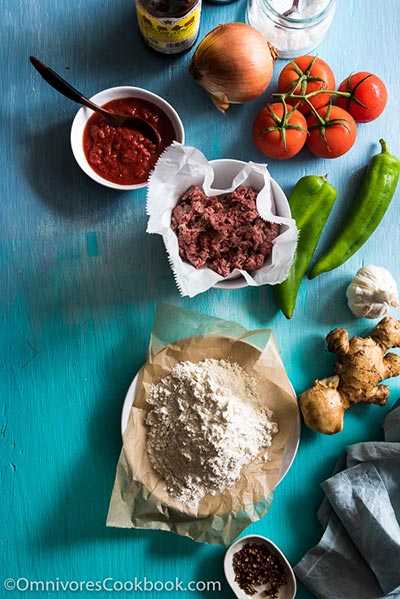Written by: Bai Yun
Posted on: June 08, 2017 |  | 中文
| 中文
Xinjiang Noodles (source: Sapore di Cina)
When mixed well with a sauce made of fried meat, mutton or beef and vegetables, one plate of plain noodles is the most satisfying food for the people of Xinjiang. Indeed, homesick Xinjiang people will nostalgically recall the taste of the food – chewy and richly sauced, hand-stretched noodles – no matter where they travel to.
The Xinjiang noodle originated from the Shanxi Province and was not called “stretched noodle” until the 1950s. When introduced from inland China to Xinjiang through the ancient Silk Road, the noodle was well received. It became integrated with local cuisine and flavour, and quickly became a famous local food. Enjoyed by all, it was to be found on the dinner tables of common people as well as at grand banquets and feasts.
Due to its long hours of sunshine, and sharp temperature differences during day and night, Xinjiang harvests a remarkably good quality of wheat. This wheat is used for the excellent flour from which the noodles are eventually made. The vegetables and meat carefully chosen for the sauce are sometimes said to reflect the personality of Xinjiang’s people: straightforward and warm-hearted. The connection between the people and the noodle goes beyond just the symbolic. It is said that Xinjiang people feel weak and faint if they do not take at least one meal consisting of Xinjiang noodles, within a span of three days. Considering that the dish is full of nutrition in addition to being simple and tasty, this is hardly surprising.
In everyday life, a mother will prepare plates of noodles with sauce, in order to feed the entire family. This is regarded as the display of her love for them, and a part of this love is ensuring that the family is getting enough nutrition. Since different vegetables have different kinds of nutrition, it is considered better to have more of them. As a result, small pieces of red tomatoes, green garlic sprout, flavourful onion and green and red chilli pepper can be found in the dish. Bits of yellow egg and deep fried mutton or beef complete the meal. The final bowl is full of colour, taste and nutrition.
In earlier times, every Xinjiang child knew that the father is the one who eats noodles for lunch, while the mother is the real magician, who makes the meal ready in no time. Through selecting, clearing, cutting and stir-frying, a bowl of fried meat and vegetables comes about. From kneading, cutting, twisting, stretching and boiling of dough, a plate of noodles is served. In those times, fathers would take up the responsibility of making a living, while mothers would try their best to feed the growing children, who, it can be imagined, were always asking for more noodles. Time fell through the hands of many mothers, and unduplicated tastes were created from their fingertips. With their efforts, the noodle became longer and longer. And like the thread of a kite, no matter where Xinjiang people went, the noodle kept showing the way home.

If stirred well and properly mixed, the noodles and sauce can become the best companions, the final dish full of an unforgettable taste. Based on the different ingredients present in the sauce, the noodle has different flavours, and thus is given different names, such as noodle with deep fried oily meat, simple noodle with plain vegetables, or noodle with dried chilli sauce. Just like the process of its development, the Xinjiang noodle is an outcome of the acceptance and integration of cultures along the Silk Road and in Xinjiang. The food itself indicates the features of Xinjiang province: inclusive, grand and practical.
With the passage of time, noodles, no matter how simple they may seem, have taken on a significant role in the Xinjiang cuisine, with more varieties being created, such as chicken sauce noodle, pigeon sauce noodle, and even western-style noodle. At present, there are at least a hundred different sauces which have been created to complement the stretched noodle. Some restaurants now serve the noodle buffet, where several kinds of sauces will be provided for the foodie to choose from, all equally good. However, with so many choices, the question naturally emerges: which noodle is the best? The answer may vary depending on who you ask, for Ili people would recommend that Ili noodles are the best, but Turksun (a county in Turpan Basin) people insist that they offer the noodle with the most flavour, and Qitai (a county in the edge of Zhunggar Basin) people would argue that their noodle is the most authentic. In every corner of Xinjiang, you will find the noodle being served with a special localized sauce.
The importance of the noodle can be recognized in that a Xinjiang Noodles Culture Tourism Festival has been annually held in Xinjiang for the past three years. Moreover, in August 2015, at the fourth Yining Folk Culture Tourism Festival, Ili Noodle, with its sixty different kinds of sauces, made a record recognized by the Shanghai Great World Guinness Records. Also in August 2015, a Xinjiang restaurant named Eden Silk Road opened its doors in San Francisco, California, USA. The first of its kind Xinjiang catering enterprise to open in the USA, it serves Xinjiang noodles, and other typical Xinjiang cuisine, such as Nang bread, pilaf (polo), etc. It is fascinating that what was once a simple, home-made food has now managed to go abroad and delight the taste buds of people from around the world.
You may also like: